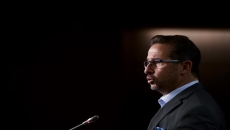Parliament’s budget watchdog is predicting another multibillion-dollar increase in the cost of a new fleet of warships for the Royal Canadian Navy, pegging the price for what was already the largest military procurement in Canada’s history at more than $77 billion.
Parliamentary budget officer Yves Giroux’s latest estimate is $17 billion more than the government’s stated price for the 15 warships, which are to be built in Halifax over the next two decades and form the Navy’s backbone for most of the century.
Giroux’s estimate is in a highly anticipated report released Wednesday that is likely to set the stage for some tough discussions — and heavy industry lobbying — on whether Canada should push ahead on the project or change tack.
To that end, the budget officer’s report includes a number of potential scenarios designed to provide a clearer picture of what options are available to the government should it decide to go in a different direction — and how much each would cost.
That includes scrapping the existing plan to base the 15 warships on the British-designed model called the Type-26, which Canadian defence officials have repeatedly described as the right ship for Canada, and choosing a different design for the fleet.
Giroux and his team also looked at the idea of a hybrid fleet, in which Canada builds three Type-26 ships and supplements them with 12 other vessels. That would mimic how the Navy was previously built, with three Iroquois-class destroyers and 12 Halifax-class frigates.
Read more in the PBO's latest report: "Canadian Surface Combatant (CSC) Project: The Cost of Type 26 and Alternate Designs" https://t.co/UD1klAyEz1 pic.twitter.com/AYpt1jkowT
— Parliamentary Budget Officer (@PBO_DPB) February 24, 2021
The Type-26 frigate is also being built by the United Kingdom and Australia, but Canadian officials have been making numerous changes to the design to meet Canada’s unique military and industrial requirements.
Those changes have been made more complicated by the government’s attempts to pack all the capabilities from the Navy’s now-retired destroyers and existing frigates into one type of ship.
The destroyers provided air defence while the frigates specialize in hunting submarines.
The PBO found that the government could save $40 billion if it built only three Type-26 frigates and supplemented them with 12 smaller, less capable Type-31s, which is similar to what Britain has decided to do.
Canada could also save $50 billion if it scrapped plans to build any Type-26s and went with an entire fleet of Type-31s, according to the report, though the PBO notes that the Type-31 was “designed to operate alongside the ‘higher-end’ Type-26.”
Restarting the entire project could result in a four-year delay to the start of construction.
Giroux acknowledged during a media briefing that building a “hybrid fleet” would incur added costs over the long term due to the need for more training and spare parts for different types of ships, among other things, which were not figured into his calculations.
“It also means that you don't put all your eggs in the same basket,” he added. “So if you find a major defect in one class of ship, you have a fallback option. You're not bound by 15 ships.”
The PBO also looked at the potential cost to switch to a type of warship called the FREMM that is currently being built for the United States and which Giroux described as on par with the Type-26 in its capabilities.
The budget officer found a revised project would cost around $71 billion whether the government decided to build an entire fleet of FREMMs or three Type-26s and 12 FREMMs.
Defence Minister Harjit Sajjan’s office and the Department of National Defence did not respond to questions on Wednesday.
The warship project was launched in earnest nearly a decade ago when Irving Shipbuilding in Halifax was selected in October 2011 to build the fleet, with the total cost estimated at around $26 billion and the first ship to be delivered in the mid-2020s.
That vague schedule remained largely unchanged, at least on paper, even as the estimated price tag ballooned to $60 billion and Ottawa ordered several smaller ships so Irving would have work until the surface combatants were ready for construction.
Defence officials revealed to The Canadian Press earlier this month that construction on the first Type-26 is set to begin in 2023-24, with the ship now due for delivery in 2030-31. Yet they insisted at that time that $60 billion remained sufficient to pay for the ships.
Sajjan and chief of the defence staff Admiral Art McDonald also appeared in a promotional video for a new design facility for the Type-26 that was organized by BAE Systems, which designed the warship, suggesting the government is doubling down on the warship.
“As a taxpayer, I really hope they're right on the $60 billion — and even lower if they can,” Giroux said. “But we're confident that our cost estimate is the most likely scenario: $77 billion. I'm confident we have an accurate cost estimate.”
Giroux said his team’s analysis found a one-year delay in the project would add $2.3 billion to the overall cost, while a two-year delay would result in the fleet costing $4.8 billion more.
Wednesday’s report is the result of a request from a parliamentary committee for the PBO to look into the warship project, and had been highly anticipated given the amount of money involved and the relative lack of information about the project from the government.
It also comes as the federal auditor general prepares to release her own report Thursday on the federal government’s entire shipbuilding strategy, which includes not only the 15 new warships but dozens of other vessels for the Navy and Canadian Coast Guard.
The Naval Association of Canada, which represents current and retired naval officers, sent a commentary to members of Parliament last month warning them to exercise caution when it came to Wednesday’s PBO report.
Giroux acknowledged that naval officials are in a better position to determine what the Navy needs in its new fleet, and that each of the different designs provide pros and cons. However, he said MPs asked his office to look at the costs, “and that’s what we did.”
“Ultimately, it's up to decision-makers to make these trade-offs as to what the Navy needs and what Canada can afford,” he said. “And by providing them with these cost estimates, we're allowing them to have better information to make these important decisions.”






